Posted by Cameron on 07.18.07 11:22 PM
 Welcome to part two of our garden tour! A little over a year ago, we landscaped the dirt-and-weed festival behind our house, using edible (or fruit-producing) plants wherever possible. This summer, our patch is coming to life, and we’re giving you a virtual look around.
Welcome to part two of our garden tour! A little over a year ago, we landscaped the dirt-and-weed festival behind our house, using edible (or fruit-producing) plants wherever possible. This summer, our patch is coming to life, and we’re giving you a virtual look around.
During our last visit, we met Unruly Lavender and Lazarus the Lemon Verbena. Today, we venture into the Northside Fruit Preserve.
Just past Lazarus, at the corner of the deck (which marks the northwest corner of the garden) is our Santa Rosa plum tree. We have been advised by wise people that fruit production won’t really kick in until next year, but we’re getting a few this year, and they’re really tasty.
As we step away from the deck, we meet the next member of the Northside Preserve: a makrut (kaffir) lime tree that is far happier in our dry, cool Mediterranean climate than I would have thought possible. We know of at least one other person with a successful makrut lime who lives not far from us, but I am still bemused by this enthusiastic little refugee from the tropics. We will never lack for leaves in our Thai culinary adventures and it’s starting to look as if we may see some limes this year. They’re not much as fruit, but the zest is useful.
Tucked far too close to the fence in the northeastern corner is our bergamot tree. It seems to be doing well, although it hasn’t decided to go all lush with the fruit yet. I’m torn between a desire to prune it and the feeling that I should just let it do its thing. I’ll probably nip it a bit to give it some shape the next time I’m wandering around with the appropriate implements.
Around the base of our mini-orchard, we have two rosemary plants that are doing their best to imitate kudzu. I can’t say that I’m surprised, as rosemary grows absolutely everywhere in San Francisco. These specimens have contributed spears and leaves to everything from the Rosemary Five and Gin-gin Cooler to steak fiorentina.
Along much of the eastern wall of the garden, there is really nothing to eat, although that will change if the fennel that I just planted takes hold. In the meantime, a line of lilies and the magnolia tree are the lone survivors from the yard’s previous incarnation. The magnolia turned out to be beautiful once it got a haircut, with a main trunk sporting white blooms next to a cluster of volunteer shafts that produce purple flowers. They all seem like they’re from the same root structure down underneath the ground, but I’m not entirely sure how that’s possible, given the combination of blossom colors.
In the southeastern corner (again, too close to the wall), a Meyer lemon tree is holding its own against the magnolia. This tough trooper started delivering fruit practically as soon as it was planted and bids fair to give a repeat performance this year. I can’t wait. For a boy raised on New England summers and snows, there are few things as satisfying as nipping out to the garden for a fresh lemon.
Next: Dog-eating vines? Thyme will tell!





garden
2 Comments »




Posted by Cameron on 07.11.07 11:46 AM
 All spring, we watched the stone fruit come in at the Ferry Plaza farmers market. This year I noticed the cherries first, followed by peaches and what seems like a ridiculous bumper crop of apricots. Meanwhile, our young Santa Rosa plum tree poked lazily through its growth cycle. Flowers came and went, followed by small green globes that grew slowly and eventually blushed yellow.
All spring, we watched the stone fruit come in at the Ferry Plaza farmers market. This year I noticed the cherries first, followed by peaches and what seems like a ridiculous bumper crop of apricots. Meanwhile, our young Santa Rosa plum tree poked lazily through its growth cycle. Flowers came and went, followed by small green globes that grew slowly and eventually blushed yellow.
Looking back, I had a very funny reaction. Even as the fruit passed through red on their way to purple, I didn’t think, “Those will be ready to eat soon.” Instead, I marveled at how impossibly bright they seemed and wondered if there was any way to capture the ghostly neon luminescence with a camera. The branches of our bergamot and lemon trees had been bare for so long that fruit was something that we bought at the Ferry Plaza. I had unwittingly come to see our own plum tree as a pretty abstraction.
Then I walked out into the yard last week and found that a plum had dropped to the ground. I didn’t think too much of it. The plum didn’t really look ripe and it felt a bit hard, but it did smell good. I took it up to the kitchen and called Anita to look. We took a few pictures, and then I cut into the fruit with a small knife and everything changed.
The juice ran out over the blade of the knife and my hand and dripped on the floor. Startled, I moved over to the sink, finished cutting a wedge, and ate it. The flesh was sweet, and tart near the skin, and it was as juicy and wonderful as any plum that I had ever eaten. Anita and I shared the rest of the plum through big goofy smiles. This was what we had to look forward to. We had loved our tree and it was becoming real.
The next day, there were more drops. I gathered three, and then a fourth and a fifth. Cradling them against my chest, I reached up and pulled gently on another likely candidate. It whispered free into my hand. I ran upstairs, deposited my load and returned with a bowl, circling the tree and tugging gently on the ripe fruit, until I had 13 in all.
We never thought that we’d eat them all before they went soft — we don’t usually keep fresh fruit for snacking. But these little devils are scandalously fragrant and once I smell one, I have to eat it. Anita has plucked more while I’m traveling in NYC, and we’ll soon have enough for a batch of brandied plums.
I still can’t believe that we’re growing fruit in our back yard. I left town on Sunday, but Saturday morning we were at the market as usual. I stopped at one of the stalls where we’d bought peaches, picked up one of their Santa Rosa plums, sniffed it, and then tasted a sample wedge. It was good. I like mine better.





garden
6 Comments »




Posted by Cameron on 06.28.07 7:00 PM
 At the beginning of June, we celebrated our fifth anniversary and spent part of the weekend in Napa. One of the highlights was a stop at Hoffman Farms. As Anita has written, we picked seven pounds of green walnuts in the dappled shade of a stand of trees that pushed up from dry, level soil.
At the beginning of June, we celebrated our fifth anniversary and spent part of the weekend in Napa. One of the highlights was a stop at Hoffman Farms. As Anita has written, we picked seven pounds of green walnuts in the dappled shade of a stand of trees that pushed up from dry, level soil.
Mr. Hoffman was kind enough to tell us what to look for as we picked, and we had the pleasure of chatting with him about his farm while we visited. Being around so many growing things started me thinking about our own garden — the experiment in edible landscaping that we began shortly after we moved into Chez Moultrie.
When we bought our house, the back forty (feet, that is) was absolutely disgusting: a flea-infested dirt-pit and dog-toilet, dominated by a sterile avocado tree, a junk fruit tree, a bottlebrush tree, and a badly overgrown magnolia. The avocado was as tall as the house and leaning dangerously, the “fruit” tree produced small cherry-like things that tasted awful, and the bottlebrush was also as tall as the house and sported a canopy at least 20 feet wide. Even though we had a list of house renovation projects as long as the trees were high, we had learned our lesson from a previous series of “why didn’t we do that sooner” landscaping episodes. The backyard would be our first project.
As our guiding principle, we decided that we would only choose plants that would produce fruit or could be eaten. We had a couple of must-haves (or rather, “hope-they’ll-grows”), and we enlisted a local landscaper to help choose the rest. We started work in March 2006, and by the end of May our backyard was transformed. Just slightly over one year later — and with summer beginning — it seems like a good time to take a full tour. I’ll spread it out over a few episodes so that we don’t get too tired. Put on your grubbies, and let’s get started.
We enter the yard from the lower deck, down a couple of steps to the patio. On the left, you’ll notice our bed of lavender. If it looks a bit disheveled, it’s because I took to it vigorously with the clippers a few weeks ago. If there’s one thing that I can’t abide, it’s uppity lavender, and this pack had started acting like it owned the place. Nevertheless, it’s pretty and it smells good. Unfortunately, smelling good is about all that this particular breed is good for; I asked for lavender, but I didn’t specify the type, and our type doesn’t do so well for cooking. On the bright side, the flowers make a very pretty garnish and if we need insecticide or air freshener, we’re all set. Live and learn — and maybe rip and replace with a culinary variety next year.
Continuing along the deck fence line, we see Lazarus the Lemon Verbena. This past winter, while facing a Day of the Triffids-caliber invasion of oxalis and other assorted weedy marauders, I’m ashamed to say that I resorted to chemical defenses. Powerful chemical defenses that came in spray bottles with warnings on the back and front. Careful as I was, some of the nearby plants paid an awful price including, I thought, the verbena. Within days, every single green leaf turned brown and dropped off, leaving behind a bleached tangle of branches lashed to the fence like a skeleton in a roadside gibbet.
Crushed and guilty, I wrote it off but left it in place, lacking the time or the energy to tear it out. Lo and behold, as winter turned to spring, the small green tips of fresh leaves poked out on a few branches. Today, it swaggers with such rude health that we’ve stopped shooing the dogs away from it; as far as they’re concerned, it’s one big salad bar. Did it really die and return to life? Well…no. My adventures with weed control happened to coincide with a few frosty evenings and the leaf drop was as natural as the seasons turning. We haven’t yet made the verbena the subject of a food project, although it did play a supporting role as garnish in last week’s Le Bourget. But the plant is waving about with such vigor that it’s only a matter of time — I’m sure it could spare a few leaves so that we can try our own version of Shuna’s verbena-infused ice cream, or perhaps an infusion.
And even though the verbena was just doing what plants do, the shower of brown leaves was an accusation as penetrating as the beating of that tell-tale heart. I don’t know what I’ll do when the next rainy season animates a green army of weeds, but I’ve sworn a mighty oath to resist the lure of chemical solutions (if you’ll forgive the pun). As I write this, I’m waiting for the sun to go down so that I can retrieve the container of ladybugs currently hibernating in our downstairs refrigerator and release them in the yard: a beetle Delta Force ready to kick some aphid butt.
Next time: The Northside Fruit Preserve and the magnolia that goes both ways!
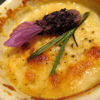

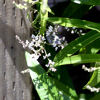
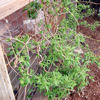

garden
3 Comments »




Posted by Anita on 04.20.07 10:47 PM
 After much hemming and hawing, I decided there aren’t enough good reasons not join in next week’s Penny-Wise Eat Local Challenge. So, we’ve committed to spend a week — or, in our case, six days — eating as much as we can from within our foodshed.
After much hemming and hawing, I decided there aren’t enough good reasons not join in next week’s Penny-Wise Eat Local Challenge. So, we’ve committed to spend a week — or, in our case, six days — eating as much as we can from within our foodshed.
As if consuming foods grown or produced exclusively within a short radius of our home wasn’t hard enough, we’re also doing it on less than $144 a week, plus a mere $8 (!) for alcohol, in an effort to prove that it’s possible to be a locavore without spending any more than the average American two-person, two-earner family.
Coming from our house, where we have been known to spend $144 on a single dinner and $8 on one cocktail, this is going to be …interesting. But luckily, we have a gorgeous new kitchen where we love to cook these days. As for dining out, that’s one reason for our loose interpretation of the challenge week (the official start of the event isn’t until Monday the 23rd): We’re attending a benefit for a very worthy cause on Thursday night, and it doesn’t feel right to pinch pennies under the circumstances.
I’ve also done my best to plan meals for this week that are within the grasp of the average American home cook, both in terms of technique and ingredients. I’ve got a serious edge, living in the Bay Area, where we have so many great local artisans and farmers within close reach, so I didn’t want to stack the deck any further by choosing esoteric items or high-falutin’ preparations.
As far as exemptions go, I am allowing myself the so-called “Marco Polo rule”: I’m not tying myself to local spices, nor small quantities of condiments. Cameron’s going to continue to drink his coffee (it’s from Peet’s, a local establishment) and I feel no need to abandon my nasty Fresca habit. We’ll add the cost of these items to our budget, as well as any other non-local items we consume. We’re also buying bread that I have to assume is baked with non-local flour, but at least we’ll be supporting local artisans.
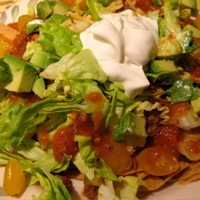 And because some of our favorite items come from slightly further afield, we’re going to extend our challenge radius to 200 miles, from the standard 100. But mostly, when we have a choice, we’ll opt for a product grown or made as close to us as possible. We’ll also be using fruits and herbs from our own garden, so perhaps that will keep our average distance down.
And because some of our favorite items come from slightly further afield, we’re going to extend our challenge radius to 200 miles, from the standard 100. But mostly, when we have a choice, we’ll opt for a product grown or made as close to us as possible. We’ll also be using fruits and herbs from our own garden, so perhaps that will keep our average distance down.
Tonight’s dinner was an old favorite, a taco-salad-like dish known in my family as “Walking Tostadas.” I sauteed some ground beef in a skillet, added some taco seasonings and a pureed tomato, and simmered. On the plate, the dish is simply a handful of broken tortilla chips, topped with the taco meat, then some shredded cheese, lettuce, salsa, tomatoes, avocado, and sour cream.
Here’s how it breaks down…
chips: 1/6 of a bag from Rancho Gordo (Napa / 50 mi) — $1
ground beef: 1 pound Prather Ranch (Shasta / 200 mi)– $6
tomato for puree: Whole Foods “locally grown” (Dinuba / 200 mi) — $0.66
lettuce: 1/2 of a romaine heart: Earthbound Farms (SJ Bautista / 88 mi) — $0.50
cheese: 1/2 wedge raw-milk chipotle cheddar Bravo Farms (Traver / 225 mi) — $1.50
crema: 2oz creme fraiche Bellwether Farms (Tomales / 50 mi) — $1.33
salsa: 2oz prepared Primavera (Sonoma / 50 mi) — $1
avocado: 1/2 a small one, part of a $3 grab bag from Will’s (Soledad / 130 mi) — $0.50
grape tomatoes: 1/6 of a large bunch from Balakian Farms (Reedly / 200 mi) — $0.50
(edit: The grape tomatoes were from Bruin Farms in Winters, 65 miles away)
Total this meal: $12.49 with plenty of leftover meat
I’m not going to go into this level of detail all week, I promise. But so far, I’ve estimated we’ll spend a good bit under our budget. Tomorrow’s trip to the farmers market will be the real test, but the most expensive items — meat and cheeses — are very predictable.
cooking, farmers markets, garden, locavore, other blogs, shopping
4 Comments »




Posted by Anita on 03.02.07 3:38 PM
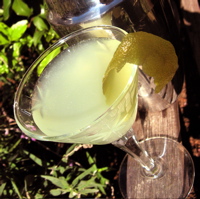 We’re all down with eating seasonally here in the Bay Area. But how about drinking seasonally?
We’re all down with eating seasonally here in the Bay Area. But how about drinking seasonally?
California growers coax most popular citrus fruits into year-round abundance, so it’s easy to forget that these tart treats — especially many of the obscure varieties — are truly winter fruits. Specifically, sour oranges like Bergamots and Sevilles have a painfully short harvest each January or February, a fact that oddly endears them to many aficionados. This same scarcity has inspired countless generations of English cooks to put up marmalades, to extend this slice of winter sunshine as long as possible.
I’m so enamored of specialty citrus that we’ve planted a miniature grove in our tiny yard: A full size Meyer lemon, a dwarf Bergamot, and a shrub-size Makrut (kaffir) lime. The bergamots we harvested this week were zested for a micro-batch of bergamocello; I hope next year we’ll have enough to make preserves or at least make a small batch of bergamot orangettes (would that be bergamettes?). But these same few fruits yielded just enough juice for a round of one of my favorite cocktails, dubbed the “Friday After Five” in honor of the eGullet thread that spawned it.
If you can’t find Bergamots, feel free to substitute fresh grapefruit juice. It won’t taste the same, of course, but then — like favas and peaches and sun-ripened tomatoes, in their turn — the drink’s fleeting flavor is part of the charm. If you’re anything like me, the haunting scent of Bergamot may even be enough to make you wish for winter in the summertime.
Friday After Five
1 ounce gin
1/2 ounce green Chartreuse
3/4 ounce bergamot juice
1 dash Herbsaint, absinthe or Pernod
Shake over ice, and pour into a chilled cocktail glass. Garnish with a bergamot twist, if desired.
Drink of the Week, drinks, food boards, garden, recipes
8 Comments »




Posted by Cameron on 02.25.07 6:16 PM
 If there is an edible gardening art more arcane or mysterious than successfully growing fruit trees, I don’t want to know what it is. The landscaping consultant whose professional advice I regularly seek is the representative of Friends of the Urban Forest in Bernal Heights and maintains an “experimental garden” where he coaxes fruit trees of all descriptions to flourish in our odd local microclimate. But even he is often reduced to a shrug. Who knows if they’ll even survive, let alone bear fruit? They’re living things, and they don’t read rulebooks — they just grow. Or not.
If there is an edible gardening art more arcane or mysterious than successfully growing fruit trees, I don’t want to know what it is. The landscaping consultant whose professional advice I regularly seek is the representative of Friends of the Urban Forest in Bernal Heights and maintains an “experimental garden” where he coaxes fruit trees of all descriptions to flourish in our odd local microclimate. But even he is often reduced to a shrug. Who knows if they’ll even survive, let alone bear fruit? They’re living things, and they don’t read rulebooks — they just grow. Or not.
So I feel incredibly blessed that the trees we’ve planted in our backyard all appear to be thriving. Our Meyer lemon is loaded with eight or nine fruits, our bergamot has two or three orbs of its own and has absolutely exploded with fresh growth, and if our itty bitty Makrut lime tree keeps growing the way that it has, I’m going to be able to build a house in it.
Right now, I’m the most excited about the Santa Rosa plum tree that last week sprouted what seems like hundreds of little green/white buds. A thin, whippy thing when we planted it a year ago, it seemed to limp through the year, leaves shotgunned by some unnamed brown fungus. But it kept growing all the while and now, after some judicious pruning, it looks strong and beautiful.
The conventional wisdom is that flowers fortell fruit. Maybe. There are so many things that can happen or not happen between now and a midsummer harvest. Not enough water, too much water, pollination failure, heat, cosmic rays, or even an injudicious application of soft jazz at the wrong moment could send things horribly astray. I hope that this summer we’ll be soaking plums in brandy, but for now it’s enough to live in the moment and love the beautiful buds and flowers as a harbinger of spring.
Bernal, garden
3 Comments »




Posted by Anita on 11.29.06 12:22 AM
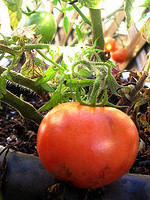 Right before we left town for Thanksgiving, I took some shots of our edible garden. It’s amazing how many things are still thriving, including the tomatoes(!) and — back from the dead! — the finicky ol’ Italian basil.
Right before we left town for Thanksgiving, I took some shots of our edible garden. It’s amazing how many things are still thriving, including the tomatoes(!) and — back from the dead! — the finicky ol’ Italian basil.
Of course, some other plants are finally going dormant for the season. At least our raggedy-ass Santa Rosa plum tree now has an excuse for looking like hell.
And, right on schedule, the citrus trees are beginning to bear some fruit. We won’t get much of a harvest this year, since the trees are so young, but there’s at least one bergamot, a few Meyer lemons, and tons of makrut (kaffir lime) blossoms.
(More pix on Flickr.)
garden
Comments Off on Zombies in the garden




Posted by Anita on 10.15.06 6:15 PM
 There’s nothing sadder than fruit left on the vine at the end of summer, with no prayer of ripening. Our not-terribly-prolific tomato plant on the back porch finally got around to setting fruit just in time for autumn’s chill, so we’ve got an abundance — yea, a vertiable bumper crop — of green tomatoes that will never become red. Luckily, the theme for this month’s installment of Hay Hay It’s Donna Day (hostessed by JenJen at Milk & Cookies) is Fritters, a perfect excuse to sizzle up some fried green tomatoes.
There’s nothing sadder than fruit left on the vine at the end of summer, with no prayer of ripening. Our not-terribly-prolific tomato plant on the back porch finally got around to setting fruit just in time for autumn’s chill, so we’ve got an abundance — yea, a vertiable bumper crop — of green tomatoes that will never become red. Luckily, the theme for this month’s installment of Hay Hay It’s Donna Day (hostessed by JenJen at Milk & Cookies) is Fritters, a perfect excuse to sizzle up some fried green tomatoes.
We got an advance review copy of the Lee Brothers’ new cookbook last week, and we’ve been testing out a few recipes. Even though I am (technically) a daughter of the South, I find most Southern cookbooks rather ho-hum. I want to love Frank Stitt, and there’s a warm spot in my heart for Miz Lewis (and her port-roasted pork shoulder, specifically), but every time I test out a new collection of Southern recipes, my response is an unqualified “meh.”
This time, I thought I’d gotten lucky. Flipping through the draft, I noticed a ton of recipes that seem a little more interesting than the norm. Sure, there’s the obligatory receipts for pimento cheese, spiced pecans and whole country ham, but then there’s also a chile relleno stuffed with cheese grits, a smattering of cocktails that breaks out of the julep-and-punch mold, and a mini-section on preserving. More than a handful of recipes boast a Sunday (fancy) and Tuesday (easy) version, and each chapter offers “QKO”s aplenty — quick knockouts that turn out impressive-but-speedy weeknight suppers.
Unfortunately, none of the recipes we’ve tried yet have been out-of-the-ballpark successes. We enjoyed the Pork Loin Chops with Pears and Vidalia Pan Gravy, but it seemed like a lot of prep work for a “quick knockout”. We both agreed we would try the Buttermilk Ice Cream again, although I’d probably add a touch of corn syrup to help with the grainy texture. (Still, if you put Fran’s caramel sauce and some toasted pecans on it, you’ll be so transported that you may not notice the less-than-stellar mouthfeel.) It’s sad that something so elemental as ice cream would need to be tinkered with, though.
Which brings us back to those tomato fritters, aka Fried Green Tomatoes. Now, my mama taught me that if you cain’t say somethin’ nice, keep your mouth shut… but just between you and me, the breading was so incredibly salty that we literally couldn’t eat the tomatoes. Which is a shame, really, as the texture was lovely, and the underlying recipe was very well planned.
It’s even more worrisome, though, that the super-salty “all-purpose dredge” used the coating is a master recipe, called for in fried chicken, fish, oysters and such. The accompanying buttermilk dressing was similarly flawed: oddly flavored and way too runny — as though the ratios were off here, too. I certainly hope that these issues are fixed in the final edition (which just hit the streets).
Here’s my modified version of the recipe:
Green Tomato Fritters
– adapted from The Lee Bros. Southern Cookbook
1/2 cup all-purpose flour
3 T stone-ground cornmeal
2 tsp salt
1.5 tsp freshly ground black pepper
1 pound green (unripe) tomatoes (2-3 medium)
1 large egg, beaten well
1/4 cup whole milk
approximately 1 cup peanut oil
salt, to taste
Whisk all of the dry ingredients together in a flat bowl or pie plate. In a second bowl or pie plate, whisk the egg and milk until well blended.
Cut the stem ends off the tomatoes and slice them 1/4-inch thick with a serrated knife.
Pour the oil into a low skillet to a depth of 1/3 inch, and heat over medium-high. Meanwhile, heat the oven to 225°F, and set a baking rack over a cookie sheet on the top rack.
Place a plate near the stove, lined with a double thickness of paper towels; have more towels handy.
Press a tomato slice into the dredge, once on each side, and shake off any excess. Dip the dredged slice into the egg wash on both sides, shaking off excess, then back into the dredge on both sides. Shake off excess coating and place slice on a clean platter. Repeat with more slices until you have enough to fill your skillet.
With a spatula — not your fingers — transfer the first batch to the hot oil in the skillet. As the first batch cooks, dredge more tomato slices, keeping an eye on the skillet. Once the slices are golden brown on one side (about 2 minutes) flip them carefully and fry for 2 minutes more or until equally brown on both sides. When done, remove to the paper-towel-lined plate, sprinkle with salt as needed, and let sit for 1 minute.
Arrange the cooked slices in a single layer on the rack in the oven, until all slices are cooked. Serve hot, with your favorite creamy buttermilk ranch-style dressing as a dip.
(For more pix, check out our Fried Green Tomatoes photo set.)
cookbooks, cooking, dessert, garden, other blogs, recipes
7 Comments »




Posted by Anita on 08.13.06 8:07 PM
It’s almost harvest time…
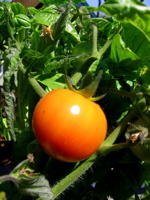
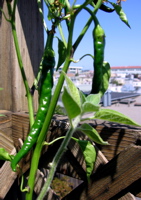
garden
Comments Off on It must be summer




Posted by Anita on 12.15.05 1:54 PM
Originally posted as part of eGullet’s Culinary Resolutions thread
In 2006, I will eat… more food that I can trace to its source.
I will make… time for entertaining friends at home.
I will find… a talented architect to remodel my kitchen.
I will learn… where to find better lunch possibilities near my office, and not just lazily fill my belly with convenient crap.
I will teach… the basics to my friends who want to learn to make Thai food.
I will read…. cookbooks from the library before I buy them, to keep my media budget sane.
This is the year I will try… to cook at least one new recipe a week.
I will taste… , at least once, anything that’s put in front of me, no matter how ‘weird’.
I will use… my new smoker (you know, the one I hope to get for my birthday) often enough to justify its purchase.
I will give… my time to the food bank, and not just when my company gives me time off to do it.
I… will fill my new garden with as many edible plants as possible.
We… will finally take our long-awaited culinary tour of Thailand.
My kids… are dogs, so their culinary needs are relatively simple.
cookbooks, food boards, garden, holidays & occasions, kitchen, Thai, travel
Comments Off on Culinary Resolutions 2006




 Welcome to part two of our garden tour! A little over a year ago, we landscaped the dirt-and-weed festival behind our house, using edible (or fruit-producing) plants wherever possible. This summer, our patch is coming to life, and we’re giving you a virtual look around.
Welcome to part two of our garden tour! A little over a year ago, we landscaped the dirt-and-weed festival behind our house, using edible (or fruit-producing) plants wherever possible. This summer, our patch is coming to life, and we’re giving you a virtual look around.








 All spring, we watched the stone fruit come in at the
All spring, we watched the stone fruit come in at the 




 At the beginning of June, we celebrated our fifth anniversary and spent part of the weekend in Napa. One of the highlights was a stop at Hoffman Farms. As Anita has
At the beginning of June, we celebrated our fifth anniversary and spent part of the weekend in Napa. One of the highlights was a stop at Hoffman Farms. As Anita has 




 After much hemming and hawing, I decided there aren’t enough good reasons not join in next week’s
After much hemming and hawing, I decided there aren’t enough good reasons not join in next week’s  And because some of our favorite items come from slightly further afield, we’re going to extend our challenge radius to 200 miles, from the standard 100. But mostly, when we have a choice, we’ll opt for a product grown or made as close to us as possible. We’ll also be using fruits and herbs from our own garden, so perhaps that will keep our average distance down.
And because some of our favorite items come from slightly further afield, we’re going to extend our challenge radius to 200 miles, from the standard 100. But mostly, when we have a choice, we’ll opt for a product grown or made as close to us as possible. We’ll also be using fruits and herbs from our own garden, so perhaps that will keep our average distance down. We’re all down with eating seasonally here in the Bay Area. But how about drinking seasonally?
We’re all down with eating seasonally here in the Bay Area. But how about drinking seasonally? If there is an edible gardening art more arcane or mysterious than successfully growing fruit trees, I don’t want to know what it is. The landscaping consultant whose professional advice I regularly seek is the representative of
If there is an edible gardening art more arcane or mysterious than successfully growing fruit trees, I don’t want to know what it is. The landscaping consultant whose professional advice I regularly seek is the representative of  Right before we left town for Thanksgiving, I took some shots of our edible garden. It’s amazing how many things are still thriving, including the tomatoes(!) and — back from the dead! — the finicky ol’ Italian basil.
Right before we left town for Thanksgiving, I took some shots of our edible garden. It’s amazing how many things are still thriving, including the tomatoes(!) and — back from the dead! — the finicky ol’ Italian basil. There’s nothing sadder than fruit left on the vine at the end of summer, with no prayer of ripening. Our not-terribly-prolific tomato plant on the back porch finally got around to setting fruit just in time for autumn’s chill, so we’ve got an abundance — yea, a vertiable bumper crop — of green tomatoes that will never become red. Luckily, the theme for this month’s installment of
There’s nothing sadder than fruit left on the vine at the end of summer, with no prayer of ripening. Our not-terribly-prolific tomato plant on the back porch finally got around to setting fruit just in time for autumn’s chill, so we’ve got an abundance — yea, a vertiable bumper crop — of green tomatoes that will never become red. Luckily, the theme for this month’s installment of